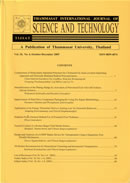ThaiScience
ThaiScience
THAMMASAT INTERNATIONAL JOURNAL OF SCIENCE & TECHNOLOGY
Volume 24, No. 02, Month APRIL, Year 2019, Pages 20 - 33
Non-scanning acquisition technique for extracting small depth difference on the area of interest
Suchada Rianmora, Maroay Phlernjai
Abstract Download PDF
The guidelines for selecting the appropriate surface acquisition method are created for capturing the geometric shape of small objects ( less than 5 cm height) that contains minor details such as small depth difference on the area of interest. Scanning (3D laser scanner) and non-scanning (a mobile phone camera) techniques were applied in this study. The results are compared using both qualitative and quantitative measurements. The non-scanning technique by a mobile phone camera is almost 80 times less expensive than the 3D laser scan while generating similar 3D models with acceptable accuracy within 1.5 mm of the master object and within 1 mm error between the two methods. The average total time used in the non-scanning is less than half of the scanning one. Detail of small depth differences on the area of interest is better captured by non-scanning one with the application of the proposed guidelines. General capabilities and limitations of both techniques, such as the object surface types, color, surface preparation and symmetry that can affect the resulting 3D model of both acquisition methods are also discussed and tabulated.
Keywords
Non-scanning technique, Optical data acquisition, Reverse engineer (RE), Scanning technique, Surface reconstructionTHAMMASAT INTERNATIONAL JOURNAL OF SCIENCE & TECHNOLOGY
Published by : Thammasat University
Contributions welcome at : http://www.tijsat.tu.ac.th
